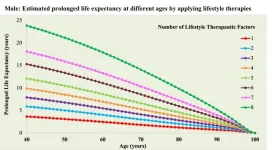MSU study links cadmium levels in women’s urine to endometriosis
2023-07-24
(Press-News.org) EAST LANSING, Mich. – Women with a history of endometriosis had higher concentrations of cadmium in their urine compared to those without that diagnosis, according to a Michigan State University study that suggests the toxic metal could be linked to the development of endometriosis.
Affecting one in 10 reproductive-age women, endometriosis is a gynecologic condition in which tissue that looks like the lining of the uterus, or womb, appears outside the uterus. Those with endometriosis can experience chronic, painful and debilitating symptoms, which can interfere with all aspects of life, including daily activity, work productivity, school performance and personal relationships.
“Despite the adverse impact of endometriosis on quality of life, it remains an understudied condition,” said Kristen Upson, assistant professor in the Department of Epidemiology and Biostatistics at the MSU College of Human Medicine and senior author of the study.
“By looking at environmental risk factors such as metal cadmium, we are moving the needle closer to understanding risk factors for this condition,” added the study’s first author, Mandy Hall, a data analyst in the MSU Department of Epidemiology and Biostatistics.
Cadmium is a toxic metal and a “metalloestrogen,” meaning it can act like the hormone estrogen. In the U.S., people are commonly exposed to cadmium by breathing in cigarette smoke and eating contaminated food like spinach and lettuce.
While this is not the first study exploring a potential link between cadmium and endometriosis, the researchers said it’s the largest study to look at cadmium measured in urine, which reflects long-term exposure between 10 and 30 years.
For their study, researchers used data from the National Health and Nutrition Examination Survey, or NHANES, a national study representative of the U.S. population between 1999 and 2006. Out of the survey’s more than 41,000 participants, the researchers limited their study population to those 20 to 54 years of age with information on endometriosis diagnosis.
The researchers then analyzed the data, dividing the cadmium levels into four classes, or quartiles, with the first quartile being the lowest exposure and the fourth being the largest exposure.
They found that participants in the second and third quartiles were twice as likely to have been diagnosed with endometriosis than those in the first quartile. The data also suggests a 60% increased prevalence of endometriosis based on urinary cadmium concentrations in the fourth quartile.
“The findings are interesting given that cadmium can act like the hormone estrogen, and this hormone is central to the development of endometriosis,” Hall said.
The researchers say further studies are needed to confirm their findings. Upson said this work is part of her larger research looking at everyday factors that may increase toxic metal exposure in women as well as the impact of toxic metals on gynecologic health. Hall plans to incorporate environmental factors in their ongoing research on endometriosis and other gynecologic conditions.
The research was supported by the National Institute of Nursing Research of the National Institutes of Health under Award Number R00NR017191. The content is solely the responsibility of the authors and does not necessarily represent the official views of the National Institutes of Health.
###
Michigan State University has been advancing the common good with uncommon will for more than 165 years. One of the world's leading research universities, MSU pushes the boundaries of discovery to make a better, safer, healthier world for all while providing life-changing opportunities to a diverse and inclusive academic community through more than 400 programs of study in 17 degree-granting colleges.
For MSU news on the Web, go to MSUToday. Follow MSU News on Twitter at twitter.com/MSUnews.
END
[Attachments] See images for this press release:


ELSE PRESS RELEASES FROM THIS DATE:
2023-07-24
Ann Arbor, July 24, 2023 - Among nearly 10 million US infants born between 2016 and 2018, breastfed babies were 33% less likely to die during the post-perinatal period (day 7−364) than infants who were not breastfed, reports a new study in the American Journal of Preventive Medicine, published by Elsevier. The findings build on previous US research with smaller datasets, which documented the association between the initiation of breastfeeding and the reduction of post-perinatal infant mortality by a range of 19% to 26%.
Lead investigator Julie L. Ware, MD, MPH, ...
2023-07-24
An analysis of real-world data from more than 1.2 million patients from health systems in four geographically dispersed states -- Indiana, Oregon, Texas and Utah -- conducted by the U.S. Centers for Disease Control and Prevention’s VISION Network, has determined both the number of adults needed to be vaccinated to prevent one COVID-19 associated hospitalization and the number needed to be vaccinated to prevent one COVID-19 associated emergency department (ED) visit.
This study is one of the first, ...
2023-07-24
A new study involving over 700,000 U.S. veterans reports that people who adopt eight healthy lifestyle habits by middle age can expect to live substantially longer than those with few or none of these habits. The eight habits are: being physically active, being free from opioid addiction, not smoking, managing stress, having a good diet, not regularly binge drinking, having good sleep hygiene, and having positive social relationships.
According to the results, men who have all eight habits at age 40 would be predicted to live an average of 24 years longer than men with none of these habits. For women, having all eight healthy lifestyle factors ...
2023-07-24
More people are drinking milk alternatives made from plant sources such as oats, soy, or almonds, but do plant-based products deliver the same nutrition as cow’s milk? Results from a new study suggest that most don’t.
Cow’s milk is an important source of calcium and vitamin D, both of which are identified in the 2020-2025 Dietary Guidelines for Americans as nutrients of public health concern for underconsumption. Cow’s milk is also a major source of protein in the American diet.
To assess how the nutritional content of plant-based milk alternatives compares to that of cow’s milk, researchers examined more than ...
2023-07-24
COLUMBUS, Ohio – When people who publicly reject COVID-19 vaccines later die from the disease, observers have complex reactions to their fates, a new study suggests.
While very few rejoice in the deaths of anti-vaxxers, some people believe those who are dogmatic against vaccines are deserving of worse outcomes – and that reaction is related to the political party affiliation and vaccination status of the person evaluating the anti-vaxxer.
Democrats and those who were vaccinated were more likely than Republicans and the unvaccinated to think anti-vaxxers who died got what they deserved ...
2023-07-24
As artificial intelligence expands across more professions, robot preachers and AI programs offer new means of sharing religious beliefs, but they may undermine credibility and reduce donations for religious groups that rely on them, according to research published by the American Psychological Association.
“It seems like robots take over more occupations every year, but I wouldn’t be so sure that religious leaders will ever be fully automated because religious leaders need credibility, and robots aren’t credible,” said lead researcher Joshua Conrad Jackson, PhD, an assistant professor at the University of ...
2023-07-24
July 24, 2023 – Characters with facial disfigurement have long been a recurring theme in films. Their characteristics and outcomes lend insights into perceptions of facial deformities and the effects of plastic surgery, reports a study in The Journal of Craniofacial Surgery under the guidance of Editor-in-Chief Mutaz B. Habal, MD, FRCS, FACS of Tampa, Florida. The journal is published in the Lippincott portfolio by Wolters Kluwer.
Movie characters who undergo successful plastic surgery to improve their facial appearance are more likely to have happy endings, according to the new research by Young Suk Kim, BA, and Kun Hwang, MD, PhD, of Armed Forces ...
2023-07-24
A new study suggests that incorporating olive oil into your diet could help reduce the risk of dying from dementia. As many countries face rising rates of Alzheimer’s disease and other forms of dementia, the study offers hope that healthy lifestyle factors such as diet can help to prevent or slow the progression of these devastating conditions.
“Our study reinforces dietary guidelines recommending vegetable oils such as olive oil and suggests that these recommendations not only support heart health but potentially brain health, as well,” said Anne-Julie Tessier, RD, PhD, a postdoctoral fellow at the Harvard T.H. ...
2023-07-24
Researchers report that blood levels of the omega-3 fatty acid docosahexaenoic acid (DHA) were inversely correlated with hearing difficulty in a new population-based cross-sectional study. Middle-aged and older adults with higher DHA levels were 8-20% less likely to report age-related hearing issues than those with lower DHA levels.
“Higher DHA levels have previously been found to be associated with a lower risk of heart disease, cognitive impairment, and death. Our study extends these findings to suggest a role for DHA in maintaining ...
2023-07-24
Losing weight is often a goal for people with type 2 diabetes, which is strongly associated with being overweight or obese. However, it hasn’t been clear what dieting strategy works best for people with this metabolic disorder.
A new randomized controlled study of people with type 2 diabetes showed that study participants who restricted eating to between noon and 8 p.m. daily lost more weight than those who reduced their overall calorie intake by counting calories. Both dieting strategies produced similar improvements in blood sugar levels.
“Many people find counting calories very hard to stick to in the long term, ...
LAST 30 PRESS RELEASES:
[Press-News.org] MSU study links cadmium levels in women’s urine to endometriosis



